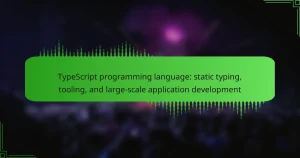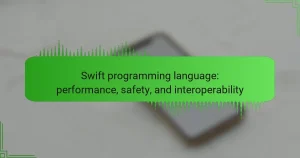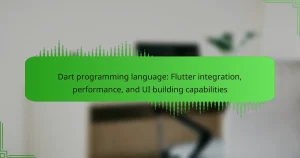Python is a high-level programming language recognized for its readability and simplicity, supporting multiple programming paradigms including procedural, object-oriented, and functional programming. Originally created by Guido van Rossum and released in 1991, Python boasts a large standard library that facilitates tasks ranging from web development to data analysis. Key libraries such as NumPy, Pandas, Matplotlib, and TensorFlow enhance its functionality, making it a popular choice in scientific computing, artificial intelligence, and data science. The active Python community provides extensive support through online forums, documentation, user groups, and conferences, fostering collaboration and knowledge sharing among users.
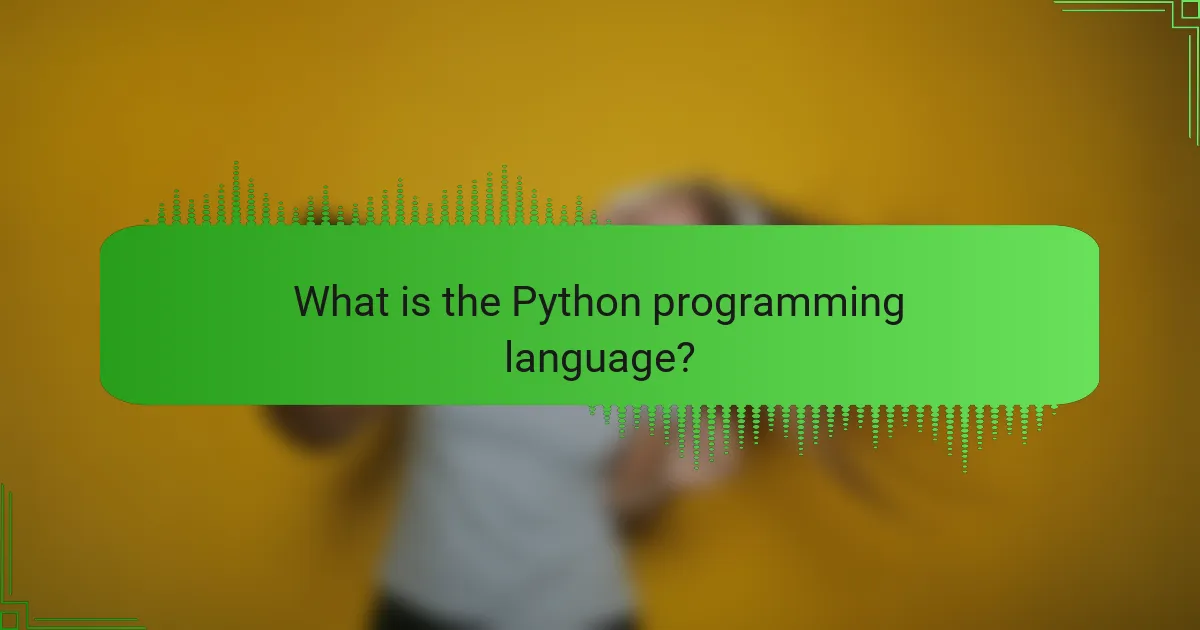
What is the Python programming language?
Python is a high-level programming language known for its readability and simplicity. It supports multiple programming paradigms, including procedural, object-oriented, and functional programming. Python was created by Guido van Rossum and first released in 1991. It has a large standard library that provides tools for various tasks, from web development to data analysis. Python is widely used in scientific computing, artificial intelligence, and web development. Its community actively contributes to a vast ecosystem of libraries and frameworks, enhancing its functionality. Python’s versatility and ease of use have made it one of the most popular programming languages globally.
How did Python evolve over time?
Python evolved from its inception in the late 1980s to a widely used programming language today. Guido van Rossum created Python as a successor to the ABC programming language. The first official release, Python 0.9.0, occurred in February 1991. This version included essential features like functions, exception handling, and the core data types of list and dictionary.
Python 2.0 was released in October 2000, introducing list comprehensions and garbage collection. Python 3.0, released in December 2008, aimed for greater consistency and removed redundant constructs. The transition to Python 3 emphasized improvements in Unicode support and standard library enhancements.
Over the years, Python’s community has significantly contributed to its growth. The language’s extensive libraries and frameworks, such as Django and NumPy, have expanded its use cases. Python has become popular in data science, web development, and automation. As of 2023, Python ranks among the top programming languages globally, reflecting its evolution and widespread adoption.
What are the key milestones in Python’s development?
Python’s key milestones include its creation in 1991 by Guido van Rossum. The first official release, Python 1.0, occurred in January 1994. Python 2.0, released in October 2000, introduced list comprehensions and garbage collection. Python 3.0, launched in December 2008, was a major revision that was not backward compatible. The release of Python 3.6 in December 2016 added formatted string literals. Python 3.9, released in October 2020, introduced dictionary merge operators. The Python Software Foundation was established in 2001 to support the language’s development. Python has grown to be one of the most popular programming languages globally, with a vast community and numerous libraries.
How has Python’s philosophy influenced its design?
Python’s philosophy has significantly influenced its design by emphasizing simplicity and readability. This philosophy is encapsulated in the Zen of Python, which includes guiding principles such as “Readability counts” and “Simple is better than complex.” The design encourages developers to write clear and concise code. This approach lowers the barrier to entry for new programmers. Additionally, it promotes collaboration and sharing within the community. The philosophy also supports a rich standard library, making common tasks easier. These principles contribute to Python’s widespread adoption in various fields, from web development to data science.
What are the core features of Python?
Python is a high-level programming language known for its simplicity and readability. It supports multiple programming paradigms, including procedural, object-oriented, and functional programming. Python has a comprehensive standard library that provides many modules and functions for various tasks. It is dynamically typed, meaning variable types are determined at runtime. Python’s syntax is designed to be intuitive and easy to learn for beginners. It features automatic memory management, which simplifies resource handling. Python is open-source, promoting a large community and extensive third-party libraries. Its cross-platform compatibility allows it to run on various operating systems, enhancing its versatility.
How does Python support different programming paradigms?
Python supports different programming paradigms including procedural, object-oriented, and functional programming. Procedural programming in Python is facilitated through the use of functions and modules. Object-oriented programming is supported with classes and inheritance, allowing for encapsulation and polymorphism. Functional programming features are available through first-class functions, higher-order functions, and lambda expressions. Python’s dynamic typing and flexibility enable easy mixing of these paradigms. The language’s extensive standard library and community-contributed packages further enhance its versatility across paradigms. Python’s design philosophy emphasizes readability and simplicity, making it accessible for various programming styles.
What makes Python user-friendly for beginners?
Python is user-friendly for beginners due to its simple and readable syntax. This simplicity allows newcomers to focus on learning programming concepts rather than struggling with complex syntax rules. Python uses indentation to define code blocks, which enhances readability. The language also has a large standard library that provides many modules and functions, reducing the need for extensive coding. Furthermore, Python’s extensive documentation and active community support make it easier for beginners to find resources and assistance. According to the TIOBE Index, Python consistently ranks among the top programming languages, indicating its popularity and usability.
What are the primary use cases of Python?
Python is primarily used for web development, data analysis, artificial intelligence, scientific computing, and automation. In web development, frameworks like Django and Flask facilitate the creation of robust applications. For data analysis, libraries such as Pandas and NumPy provide powerful tools for data manipulation and analysis. In artificial intelligence, Python’s libraries like TensorFlow and PyTorch enable machine learning and deep learning applications. Scientific computing benefits from libraries like SciPy, which provide algorithms for optimization and integration. Automation tasks are simplified using Python scripts to handle repetitive tasks efficiently. These varied use cases demonstrate Python’s versatility and widespread adoption in multiple domains.
How is Python used in web development?
Python is used in web development primarily through web frameworks. Frameworks like Django and Flask facilitate the creation of web applications. Django is known for its robustness and includes features like an ORM and an admin panel. Flask, on the other hand, is lightweight and allows for more flexibility.
Python supports server-side scripting, enabling dynamic content generation. It can also handle database interactions seamlessly. Python’s extensive libraries, such as Requests and Beautiful Soup, enhance web development capabilities. These libraries simplify tasks like API calls and web scraping.
The language’s readability and simplicity promote rapid development. According to the Stack Overflow Developer Survey 2023, Python remains one of the most popular programming languages for web development.
What role does Python play in data science and analytics?
Python is a primary programming language in data science and analytics. It provides extensive libraries for data manipulation, analysis, and visualization. Libraries like Pandas and NumPy enable efficient data handling and numerical computations. Matplotlib and Seaborn facilitate data visualization, making it easier to interpret results. Python’s simplicity and readability enhance collaboration among data scientists. Its integration with machine learning libraries, such as TensorFlow and Scikit-learn, supports advanced analytical tasks. The language’s active community contributes to a wealth of resources and tools. According to a 2021 survey by KDnuggets, Python is the most popular language for data science, indicating its significant role in the field.
How is Python utilized in machine learning and artificial intelligence?
Python is utilized in machine learning and artificial intelligence due to its simplicity and versatility. It offers a wide range of libraries such as TensorFlow and scikit-learn for developing algorithms. These libraries facilitate tasks like data preprocessing, model training, and evaluation. Python’s readability makes it accessible for both beginners and experts. The language supports various data formats, enhancing its usability in AI projects. Additionally, Python has a strong community that contributes to continuous improvement and support. Research indicates that over 80% of data scientists prefer Python for machine learning tasks. This popularity underscores its effectiveness and reliability in the field.
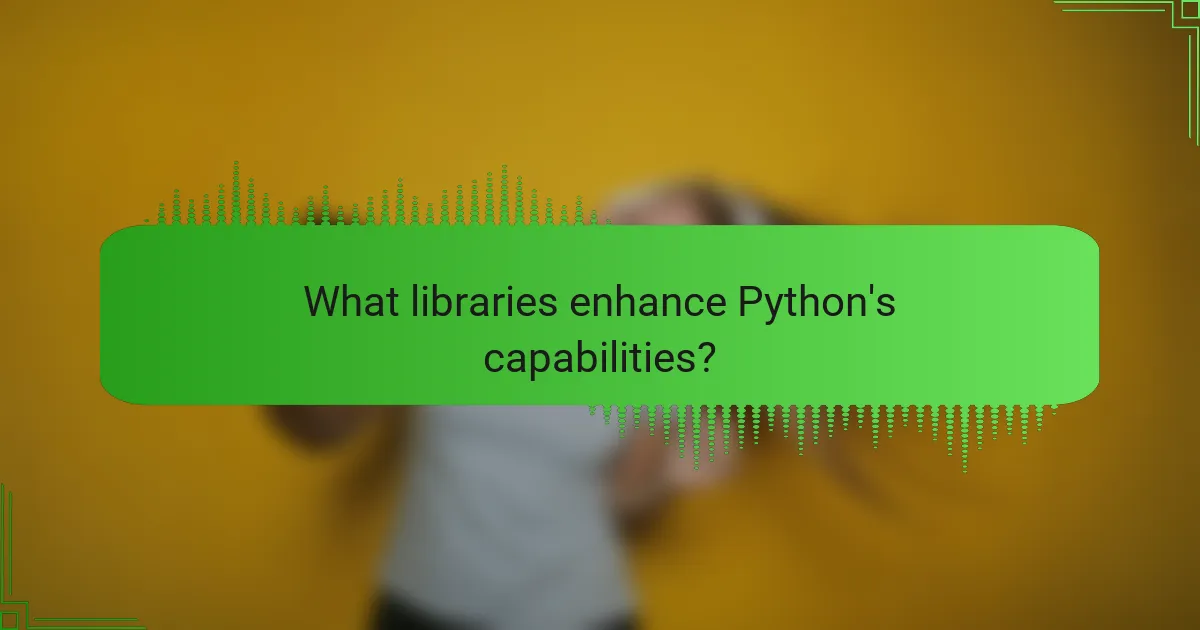
What libraries enhance Python’s capabilities?
Libraries that enhance Python’s capabilities include NumPy, Pandas, Matplotlib, and TensorFlow. NumPy provides support for large, multi-dimensional arrays and matrices. It also offers a collection of mathematical functions to operate on these arrays. Pandas is essential for data manipulation and analysis, offering data structures like DataFrames. Matplotlib allows for the creation of static, animated, and interactive visualizations in Python. TensorFlow is a powerful library for machine learning and deep learning applications. These libraries are widely used in data science, machine learning, and scientific computing, making Python a versatile programming language.
What are the most popular libraries for data manipulation?
The most popular libraries for data manipulation in Python are Pandas, NumPy, and Dask. Pandas provides data structures like DataFrames for handling structured data efficiently. NumPy is essential for numerical data manipulation and supports large multidimensional arrays. Dask allows for parallel computing and can handle larger-than-memory datasets. These libraries are widely used in data science and analytics. They are supported by extensive documentation and a large community. Their popularity is evidenced by their frequent inclusion in data analysis projects and tutorials.
How does Pandas facilitate data analysis in Python?
Pandas facilitates data analysis in Python by providing high-performance data structures and data analysis tools. It offers DataFrame and Series objects for efficient data manipulation. These structures allow for easy handling of large datasets. Pandas supports various data formats, including CSV, Excel, and SQL databases. It enables powerful data aggregation and transformation operations. Users can perform complex data filtering and indexing with simple syntax. The library also integrates seamlessly with other Python libraries like NumPy and Matplotlib. Its widespread use in data science is supported by extensive documentation and community resources.
What features does NumPy provide for numerical computing?
NumPy provides essential features for numerical computing in Python. It offers support for large, multi-dimensional arrays and matrices. These arrays allow efficient storage and manipulation of numerical data. NumPy includes a collection of mathematical functions to operate on these arrays. This enables vectorized operations, which enhance performance significantly. It also supports broadcasting, allowing operations on arrays of different shapes. NumPy provides tools for linear algebra, random number generation, and Fourier transforms. These features make it a foundational library for scientific computing in Python.
Which libraries are essential for web development with Python?
Django, Flask, and FastAPI are essential libraries for web development with Python. Django is a high-level framework that promotes rapid development and clean, pragmatic design. It includes built-in features such as an ORM, authentication, and an admin panel. Flask is a micro-framework that offers simplicity and flexibility for small to medium applications. It allows developers to add extensions as needed. FastAPI is known for its high performance and ease of use, particularly for building APIs. It supports asynchronous programming and automatic generation of OpenAPI documentation. These libraries are widely used in the industry, demonstrating their effectiveness and reliability.
How does Flask compare to Django for web applications?
Flask is a micro web framework, while Django is a full-stack web framework. Flask offers simplicity and flexibility, making it suitable for small applications. Django provides a robust set of features and follows the “batteries-included” philosophy. Flask allows developers to choose components, promoting customization. Django includes an ORM, admin panel, and authentication out of the box. Flask is lightweight and faster for small projects. Django’s structure is better for larger applications requiring scalability. Flask has a smaller learning curve, while Django has a steeper learning curve due to its complexity. Both frameworks have strong community support, but Django’s community is larger due to its longer history.
What advantages does FastAPI offer for building APIs?
FastAPI offers several advantages for building APIs. It is designed for high performance, leveraging asynchronous programming. FastAPI automatically generates OpenAPI documentation. This feature simplifies API testing and client integration. It supports data validation through Pydantic models, ensuring data integrity. FastAPI is easy to use, with a straightforward syntax. This reduces development time significantly. Its strong community support enhances learning and troubleshooting. FastAPI is compatible with standard Python type hints, improving code clarity. These attributes collectively make FastAPI a powerful choice for API development.
What libraries support machine learning in Python?
TensorFlow, PyTorch, and Scikit-learn are prominent libraries that support machine learning in Python. TensorFlow is an open-source library developed by Google. It is widely used for building deep learning models. PyTorch is another open-source library, favored for its dynamic computation graph. It is developed by Facebook and is popular among researchers. Scikit-learn is a comprehensive library for traditional machine learning algorithms. It provides simple and efficient tools for data mining and data analysis. These libraries are widely adopted in the machine learning community. They offer extensive documentation and active user support.
How does TensorFlow empower deep learning projects?
TensorFlow empowers deep learning projects by providing a comprehensive open-source library for numerical computation. It allows users to build and train neural networks efficiently. TensorFlow supports various platforms, including CPUs, GPUs, and TPUs, enhancing computational speed. The library includes high-level APIs like Keras, simplifying model development. TensorFlow also offers tools for visualization, such as TensorBoard, to monitor training processes. Its flexible architecture enables deployment across different environments, from local machines to cloud services. TensorFlow’s extensive community contributes to a wealth of resources, tutorials, and pre-trained models. This support accelerates the development of innovative deep learning solutions.
What are the key features of Scikit-learn for traditional machine learning?
Scikit-learn offers several key features for traditional machine learning. It provides a wide range of algorithms for classification, regression, and clustering. These include support vector machines, decision trees, and k-means clustering. Scikit-learn also includes tools for model evaluation and selection, such as cross-validation and grid search. It supports various data preprocessing techniques, including scaling and encoding. The library is designed for easy integration with other Python libraries, such as NumPy and pandas. Scikit-learn has extensive documentation and a large community for support. These features make it a popular choice for machine learning practitioners.
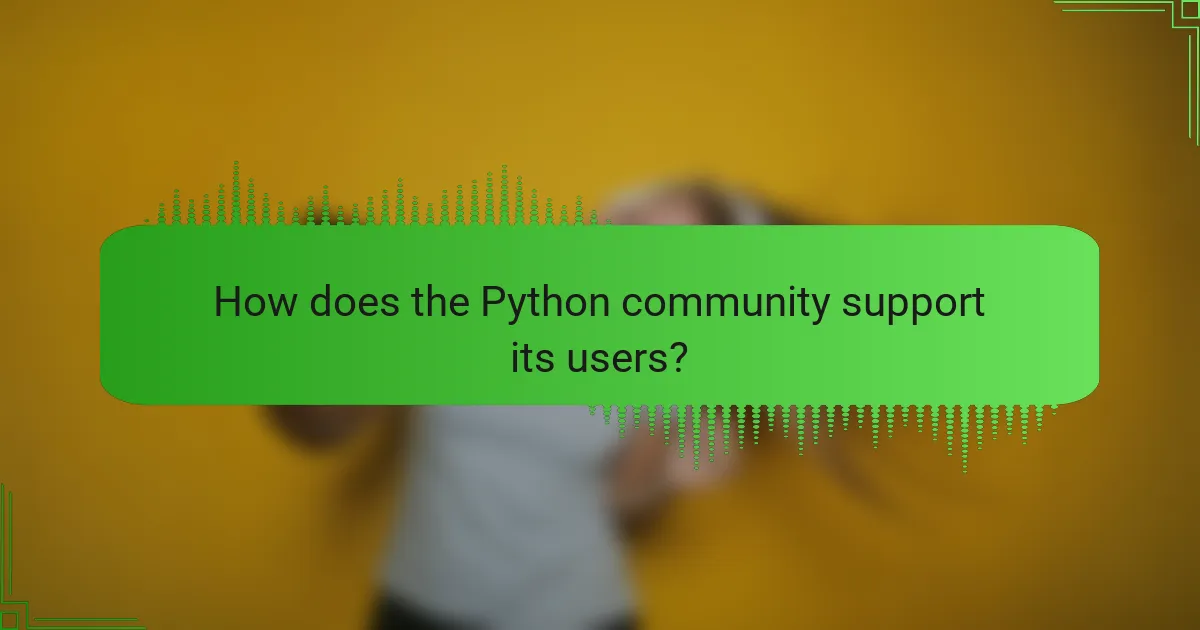
How does the Python community support its users?
The Python community supports its users through various platforms and resources. Online forums like Stack Overflow provide quick answers to programming questions. The official Python website offers extensive documentation and tutorials. User groups and meetups facilitate local networking and knowledge sharing. Conferences such as PyCon provide opportunities for learning and collaboration. Additionally, numerous online courses and resources are available for different skill levels. The community actively contributes to open-source projects, allowing users to learn from real-world code. These collective efforts create a robust support network for Python users.
What resources are available for learning Python?
Numerous resources are available for learning Python. Online platforms like Codecademy and Coursera offer interactive courses. Books such as “Automate the Boring Stuff with Python” provide practical insights. The official Python website features documentation and tutorials. Community forums like Stack Overflow and Reddit help with problem-solving. YouTube channels focus on Python tutorials and project-based learning. Local meetups and coding bootcamps offer hands-on experience. These resources cater to various learning styles and skill levels.
How do online courses and tutorials aid Python learners?
Online courses and tutorials aid Python learners by providing structured content and guided learning paths. They offer a variety of resources, including video lectures, quizzes, and hands-on projects. This format caters to different learning styles, enhancing comprehension. Additionally, many courses are designed by industry experts, ensuring the relevance of the material.
Online platforms often include community forums for peer support and interaction. This fosters a collaborative learning environment where learners can ask questions and share knowledge. Furthermore, many courses provide certificates upon completion, which can enhance job prospects. Statistics indicate that learners who engage with structured online courses often achieve higher retention rates compared to self-taught methods.
What role do books and documentation play in mastering Python?
Books and documentation are essential resources for mastering Python. They provide structured knowledge and comprehensive explanations of concepts. Books often cover fundamental topics in-depth, catering to different skill levels. Documentation offers up-to-date information on libraries, functions, and best practices. Official Python documentation includes tutorials and examples that facilitate learning. Access to these resources enables learners to troubleshoot issues effectively. Furthermore, they serve as references for advanced techniques and libraries. Mastering Python requires continuous learning, and these materials support that journey.
How does community engagement enhance Python development?
Community engagement enhances Python development by fostering collaboration and knowledge sharing. This engagement leads to the creation of libraries and tools that improve efficiency. Active communities contribute to documentation, making it easier for new users to learn Python. Collaborative projects often result in higher quality code through peer review. Furthermore, community feedback helps identify and fix bugs quickly. Events like conferences and meetups promote networking and skill development. Python’s community-driven approach has led to its growth, making it one of the most popular programming languages. Statistics show that Python consistently ranks among the top languages in developer surveys, indicating strong community support.
What are the benefits of participating in Python forums and meetups?
Participating in Python forums and meetups offers numerous benefits. These platforms facilitate networking with other Python enthusiasts and professionals. Engaging in discussions helps improve coding skills through shared knowledge. Participants can gain insights into best practices and new libraries. Forums often provide solutions to common programming challenges. Meetups can lead to collaborations on projects or job opportunities. Access to expert speakers enhances understanding of advanced topics. Community support fosters a sense of belonging in the programming ecosystem. Regular participation can keep individuals updated on industry trends and events.
How do open-source contributions shape Python’s evolution?
Open-source contributions significantly shape Python’s evolution by facilitating community-driven development. These contributions allow developers worldwide to propose new features and improvements. For instance, Python’s enhancement proposals (PEPs) are often initiated by community members. This process enables diverse input, ensuring that the language evolves to meet users’ needs.
Additionally, open-source contributions lead to the rapid identification and resolution of bugs. Developers can report issues and submit patches, enhancing Python’s stability and performance. The collaborative nature of open-source projects fosters innovation, as contributors share new libraries and frameworks.
According to the Python Software Foundation, thousands of contributors have participated in Python’s development, reflecting a vibrant community. This collective effort has resulted in significant updates, such as Python 3.x, which introduced major improvements in syntax and functionality. Thus, open-source contributions are crucial for Python’s ongoing growth and adaptability.
What are best practices for getting involved in the Python community?
Participating in the Python community involves several best practices. First, join online forums like Stack Overflow and Reddit. These platforms provide opportunities to ask questions and share knowledge. Second, contribute to open-source projects on GitHub. This enhances skills and builds connections. Third, attend local meetups and conferences. Engaging with others in person fosters relationships and learning. Fourth, follow Python-related blogs and podcasts. Staying updated on trends and news is beneficial. Finally, help others by answering questions in forums. This strengthens community ties and enhances personal understanding. These practices collectively enhance involvement in the Python community.
How can beginners start contributing to Python projects?
Beginners can start contributing to Python projects by finding open-source repositories on platforms like GitHub. They should look for projects labeled “good first issue” or “beginner-friendly.” Reading the project’s documentation and understanding its purpose is essential. Beginners can then fork the repository and create a branch for their changes. After making modifications, they can submit a pull request. Engaging with the community through discussions or forums can provide additional support. Many projects have contribution guidelines that outline the process. Following these steps helps beginners effectively contribute to Python projects.
What tips can help foster connections within the Python community?
Engaging actively in Python community events fosters connections. Attend local meetups and global conferences like PyCon. Participate in online forums such as Stack Overflow and Reddit. Contribute to open-source projects on platforms like GitHub. Collaborate with others on coding challenges and hackathons. Share knowledge through blogs or tutorials. Networking on social media platforms like Twitter can also be beneficial. These methods encourage relationship-building and enhance collaboration within the Python community.
The main entity of this article is the Python programming language, a versatile and widely-used high-level programming language known for its readability and simplicity. The article provides a comprehensive overview of Python, covering its evolution, key milestones, core features, and support for various programming paradigms. It discusses the primary use cases of Python, including web development, data science, and machine learning, while highlighting essential libraries such as Django, Flask, Pandas, and TensorFlow. Additionally, the article emphasizes the importance of the Python community, detailing resources for learning, community engagement, and best practices for contributing to Python projects.
